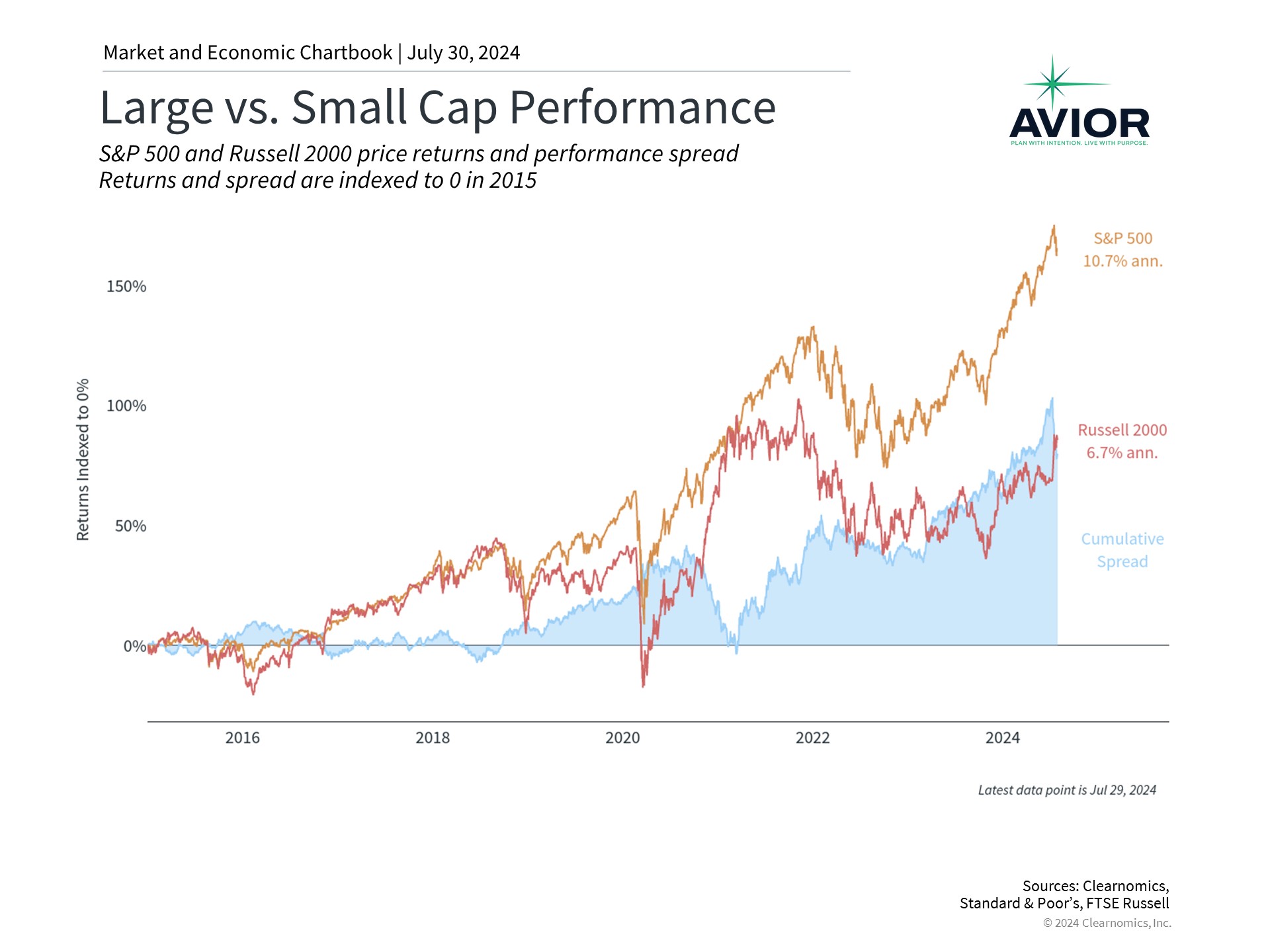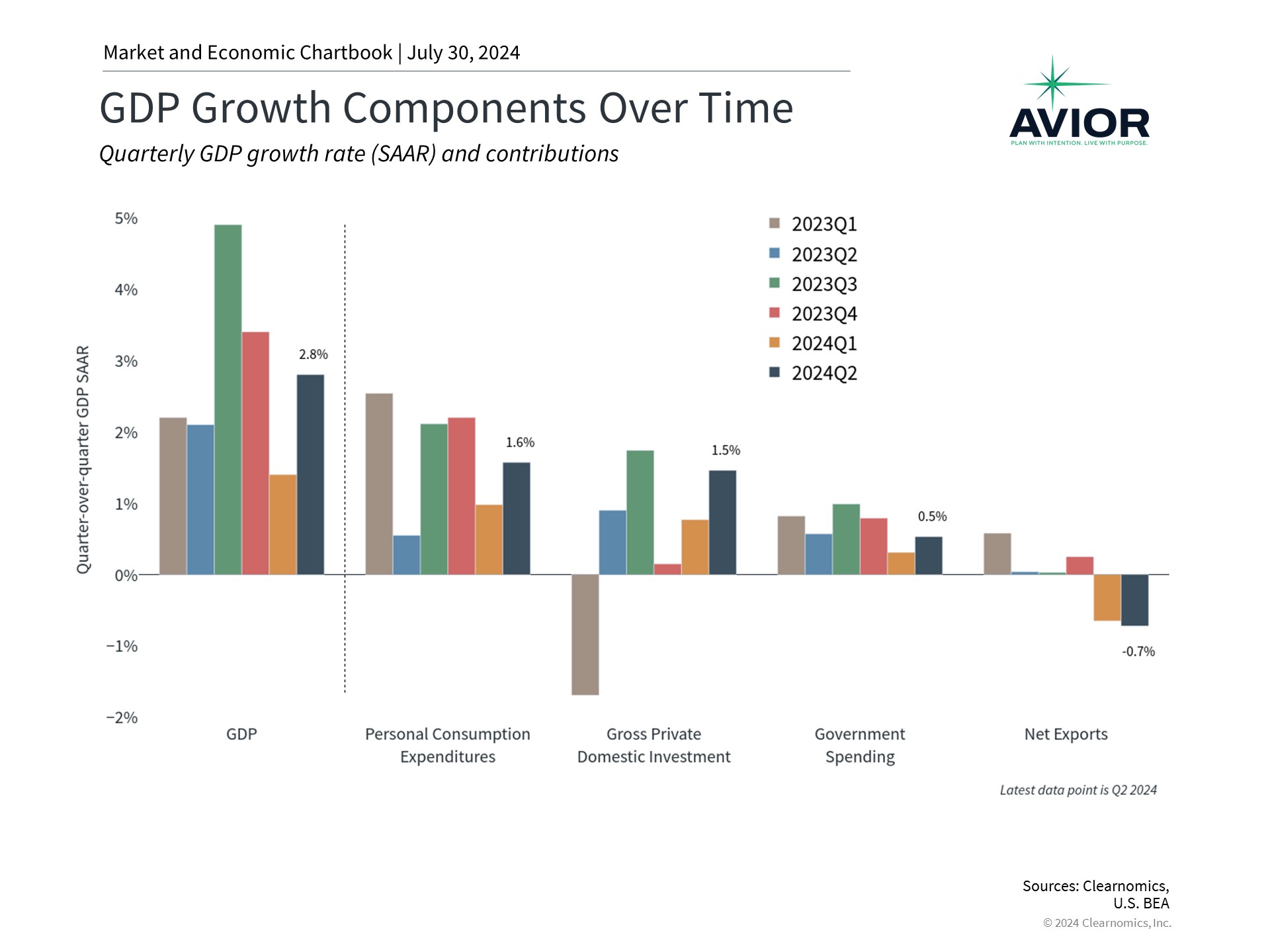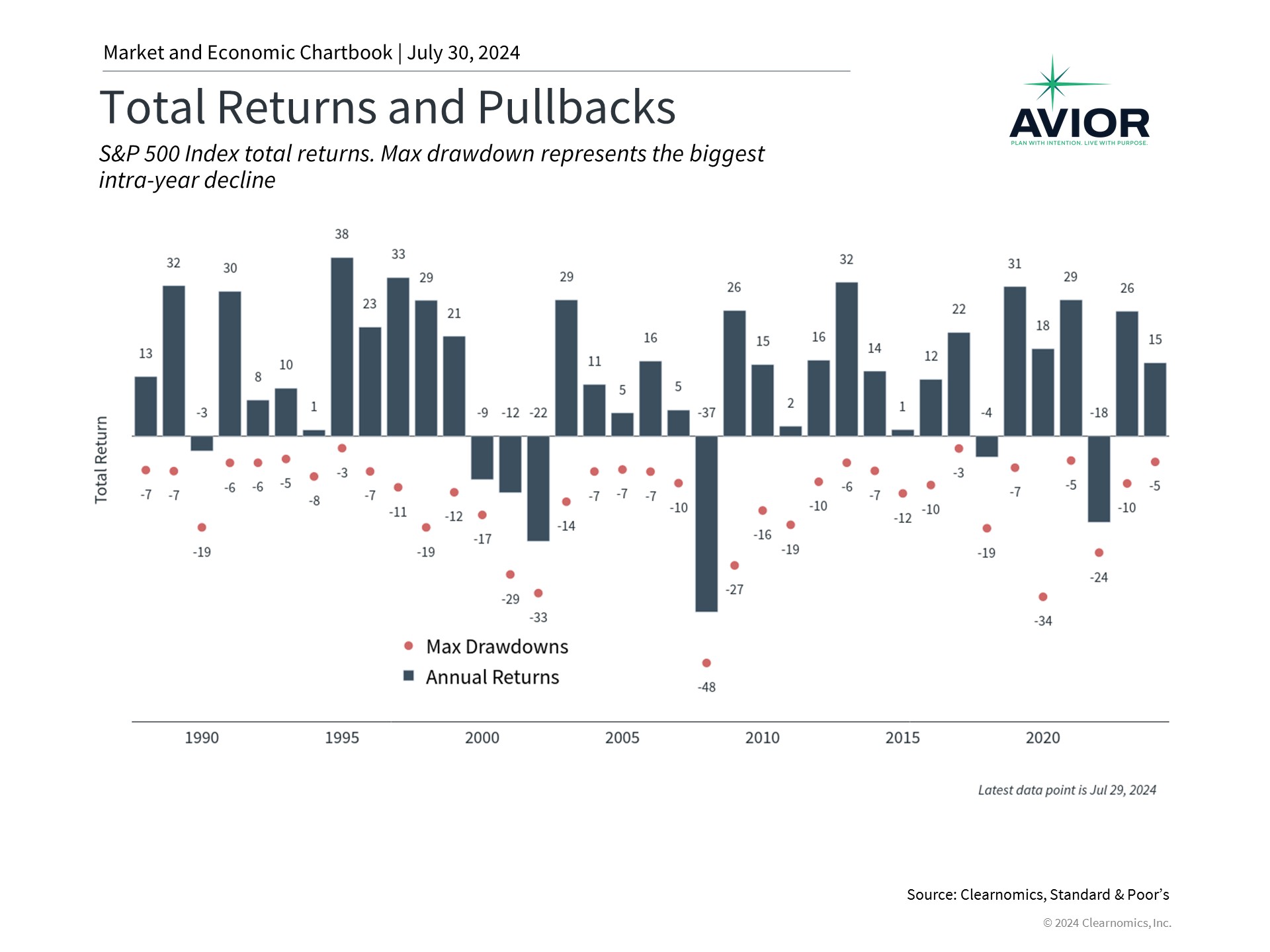What the Summer Market Rotation Means for Investors
As the summer heats up, the stock market is experiencing its own heat wave in the form of rising volatility. Market uncertainty has climbed as investors rotate out of large cap technology stocks and into a broader array of sectors and styles, including small caps. Since their respective peaks in mid-July, the Nasdaq Composite Index has declined 7% and the S&P 500 is down about 4%. Meanwhile, the Russell 2000 index of small cap stocks has jumped over 11% since early July. What’s driving this rotation and how can investors maintain perspective on upcoming events?
Investors are rotating away from large cap technology stocks

Stock market swings are never pleasant, and it’s difficult to know whether they are the result of short-term shifts or long-term trends. The presidential election is approaching and investors have many questions about what this might mean for economic policy and their portfolios. Geopolitical tensions are flaring as well, especially in the Middle East. At the same time, corporate earnings are healthy, consumer spending is resilient, and GDP growth remains robust. Through all this, the Fed is expected to begin cutting rates in just a couple of months.
In theory, lower rates should be positive for most parts of the market. So why has there been a “market rotation” rather than a continuation of the “everything rally” that we’ve experienced on and off over the past decade?
While it’s important to not overreact to market movements over a few days or weeks, it’s clear that investors are beginning to question the rally among artificial intelligence stocks. The Magnificent 7 stocks, for instance, have experienced a historic bull run of nearly 170% since the beginning of 2023, far outpacing broader market indices. By definition, market runs can’t last forever, so it was inevitable that a pullback would eventually occur – the hard part is knowing exactly when.
There are also growing questions around the billions of dollars large companies are investing in AI and whether there will be a sufficient return on these investments. This speaks to the fact that not all good ideas make for good investments, since the latter depend on paying a reasonable price.
Additionally, small caps have performed well because they tend to be more sensitive to interest rates and economic growth. This is because smaller companies tend to have less flexible financing options than large or mega cap ones, and thus benefit more when rates decline. They also tend to be less globally diversified, and thus more sensitive to domestic growth trends which recent data confirm are quite healthy.
This has resulted in a rotation rather than a broad rally. Still, there are reasons to be optimistic for the overall market. In the long run, bull markets are driven by earnings growth, and corporate earnings among large companies have been quite strong. According to FactSet, with 41% of companies having reported results this earnings season, about 78% have exceeded expectations, resulting in a projected S&P 500 earnings growth rate of 9.8%. Not only is this historically strong, but it also represents a continuation of the earnings recovery that began one year ago.
Economic growth is healthy

If market rallies are driven by strong earnings, those earnings are in turn driven by a healthy economy. According to last week’s GDP report, the economy grew at a rate of 2.8% in the second quarter, exceeding consensus expectations of 2.0%. This is a significant acceleration from the first quarter’s 1.4% growth rate. As shown in the accompanying chart, jumps in consumer spending, business investment, and government spending helped drive the headline number, with trade reducing it slightly. Despite high interest rates and fears of an economic slowdown, consumer spending was resilient, contributing 1.6 percentage points to overall GDP.
Other data support this view as well. The Personal Consumption Expenditures index is the Fed’s preferred measure of inflation, and the latest report showed that price pressures continue to improve. Overall prices rose only 0.1% in June or 2.5% year over year, a slight deceleration from the prior month, and core inflation increased only 2.6%. Across a variety of inflation measures, including consumer and producer prices, there is compelling evidence that inflation could be on track to return to 2% in the long run.
The resilience in the economy is a good sign for a continued “soft landing.” For these reasons, the market continues to believe that the Fed will cut rates once in September, then once more later in the year. Recent speeches by Fed governors seem to confirm this, with many calling for rate cuts soon.
It’s important to maintain a level head during volatile periods

As is always the case, it’s important for investors to maintain a longer-term perspective when facing periods of market volatility. This is especially true given the current economic backdrop, which should be positive for the market. Short-term pullbacks and market rotations are both normal and expected as investors evaluate new facts and data.
For example, the accompanying chart shows that the largest decline this year has only been 5%. This is quite low by historical standards, especially when compared to the strong year-to-date gains by the S&P 500 (15%) and Nasdaq (16%). Most years experience far more significant intra-year pullbacks, yet still end in positive territory.
This highlights the importance of always being prepared for stock market volatility. Pullbacks are an unavoidable part of investing, especially with heightened event risk in the coming months. How investors deal with these risks is often far more important than the risks themselves. The current rotation is also a reminder for investors to maintain diversification across a number of market areas, and not focus only on whatever is performing well at the moment. Sticking to these long term principles is still the best way for investors to achieve their long-term goals.
The bottom line? The market rotation from large caps, especially technology and artificial intelligence stocks, and into other areas such as small caps, has driven market uncertainty higher. Rather than overreacting to these moves, investors should instead maintain a long-term perspective and focus on their strategic asset allocations.
Disclosure: This report was obtained from Clearnomics, an unaffiliated third-party. The information contained herein has been obtained from sources believed to be reliable, but is not necessarily complete and its accuracy cannot be guaranteed. No representation or warranty, express or implied, is made as to the fairness, accuracy, completeness, or correctness of the information and opinions contained herein. The views and the other information provided are subject to change without notice. All reports posted on or via www.aviorwealth.com or any affiliated websites, applications, or services are issued without regard to the specific investment objectives, financial situation, or particular needs of any specific recipient and are not to be construed as a solicitation or an offer to buy or sell any securities or related financial instruments. Past performance is not necessarily a guide to future results. Company fundamentals and earnings may be mentioned occasionally but should not be construed as a recommendation to buy, sell, or hold the company’s stock. Predictions, forecasts, and estimates for any and all markets should not be construed as recommendations to buy, sell, or hold any security--including mutual funds, futures contracts, and exchange traded funds, or any similar instruments. Please remember to contact Avior, in writing, if there are any changes in your personal/financial situation or investment objectives for the purpose of reviewing/evaluating/revising our previous recommendations and/or services, or if you want to impose, add, or modify any reasonable restrictions to our investment advisory services. Unless, and until, you notify us, in writing, to the contrary, we shall continue to provide services as we do currently. Please advise us if you have not been receiving account statements (at least quarterly) from the account custodian. A copy of our current written disclosure Brochure and Form CRS (Customer Relationship Summary) discussing our advisory services and fees continues to remain available upon request or at www.avior.com.
No Comments
Sorry, the comment form is closed at this time.




